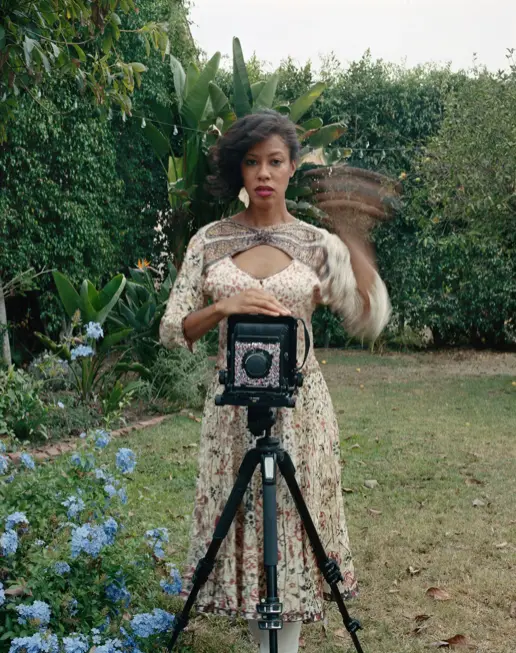Deana Lawson’s Kingdom of Restored Glory
Read Zadie Smith's New Yorker essay on Lawson's 'beautiful, imperious, unbroken, unfallen' portraits.
Full articleFor over eighteen years, the artist Deana Lawson has been engaged in the sensuous and complex depiction of black life through the principal form of the photographic portrait.
– Stanley Wolukau-Wanambwa from the essay 'Into Light', DBPFP22 catalogue
Lawson creates richly layered images and scenarios that are rooted in the familiar, but through subtle [or sometimes not-so-subtle] interventions operate as ‘portals’ that reframe the Black experience and upend stereotypes to create “an ever-expanding mythological extended family.” The protagonists in her work are generally strangers whom she has either met by chance or deliberately cast in a specific role. They are shown in intimate, staged portraits or tableaux, reflecting the vernacular language of the domestic, of family albums - as well as borrowing tropes from Art history and documentary photography - but embellished with symbols, adornments and devotional objects that both root the works within the Black diaspora and propose an additional mystical realm beyond the surface. In this place of creative and spiritual re-ordering, Lawson and her figures reign supreme.
Read Zadie Smith's New Yorker essay on Lawson's 'beautiful, imperious, unbroken, unfallen' portraits.
Full articleA Match Made in Heaven: Deana Lawson and Arthur Jafa on Destiny, Intuition, and Influence for GARAGE Magazine
The Artist Upending Photography's Brutal Racial Legacy by Jenna Wortham for The New York Times
Listen to Lawson's recent panel discussion about the state of photography today
Deana Lawson in conversation with Tracy K. Smith
Deana Lawson’s work explores how communities and individuals hold space within a shifting terrain of racial and ecological disorder. Centropy is an arrangement of photographs and spectral material that tune the space to an alternate frequency of unification. While many pictures result from chance encounters, others are obsessively searched for. Lawson seeks controlled randomness through collaborations with strangers that open new pathways of visuality and kinetic affinities. Lawson’s reverence for intergenerational connectivity within Black culture guides her choice of subjects: the presence of elders, the centrality of women, the dynamism of men, and the celestial child all make up her ever-expanding mythological extended family. Lawson’s photographs engage documentary traditions, but the construction of hybrid scenes that bridge imagined and lived realities reigns supreme. Through this dual space, Lawson sidesteps logic, and heightens dream colour, to give reverence to the body, and the unseen forces surrounding it. Everyday domestic objects and elements of adornment anchor these mythological narratives in the daily realities we navigate. Relationships of value are re-ordered, shadows move forward. Light is utilised as formative material as figures and spaces absorb wavelengths of light and reflect others in the picture taking process. The interplay between reflection and absorption is heightened by mirrored frames. The mirror is a symbolic encasing, a perimeter that not only demarcates the border of the picture, but is a reflective lining between worlds, that which is “seen” in the photograph, and that which “sees.” The holograph utilises an alternate form of optical recording. Similar but different to the process of photography, the holograph uses lasers (instead of traditional lighting) to expose light sensitive emulsion. The laser becomes a forensic tool, a metaphor to pierce normal perceived reality, portraying either familiar objects with hidden symbolism, or unfamiliar forces with untapped potential.
Deana Lawson is professor of visual arts in the Lewis Center for the Arts at Princeton University. She has exhibited internationally, including a major survey that premiered at ICA/Boston in fall 2021 and will travel to MoMA PS1 in New York and The High Museum in Atlanta. Lawson was the 2020 recipient of the Hugo Boss Prize, the first artist working in the medium of photography to be so honoured. The Guggenheim Museum, which administers the prize, presented Lawson’s solo exhibition Centropy in spring 2021. She has been the subject of numerous solo exhibitions at institutions including Kunsthalle Basel, Switzerland (2020); Huis Marseille, Amsterdam (2019); The Underground Museum, Los Angeles (2018); Carnegie Museum of Art, Pittsburgh (2018); Contemporary Art Museum St. Louis (2017); and Art Institute of Chicago (2015).

